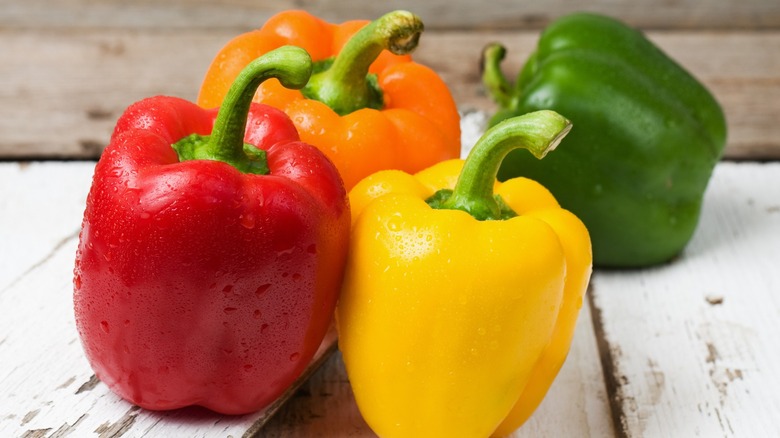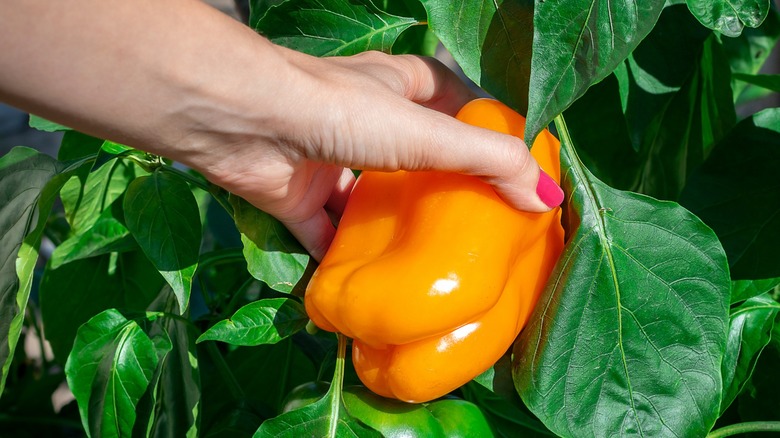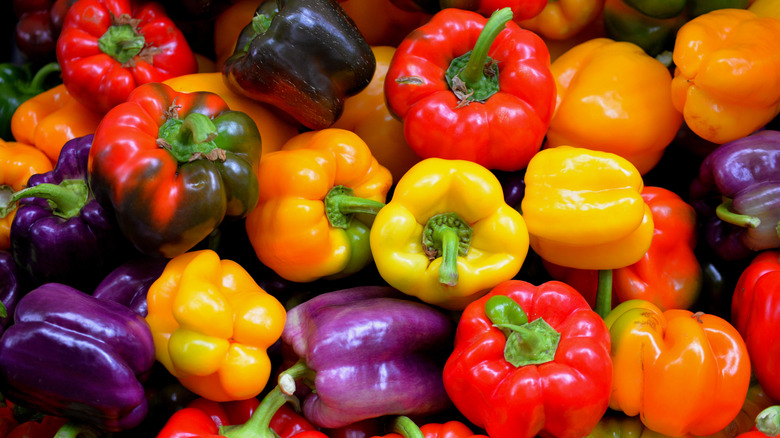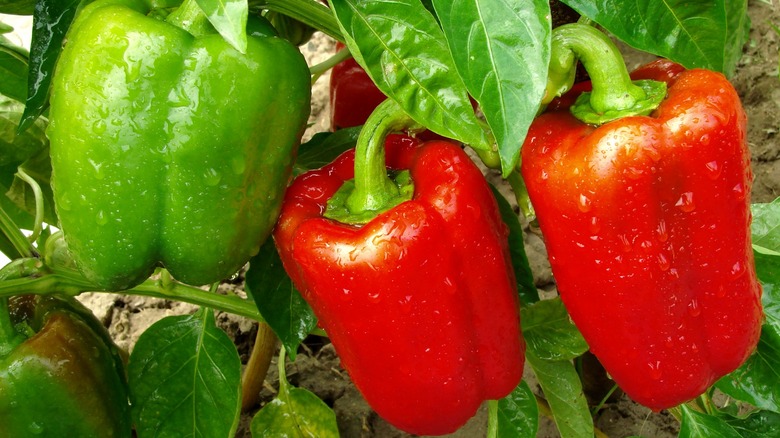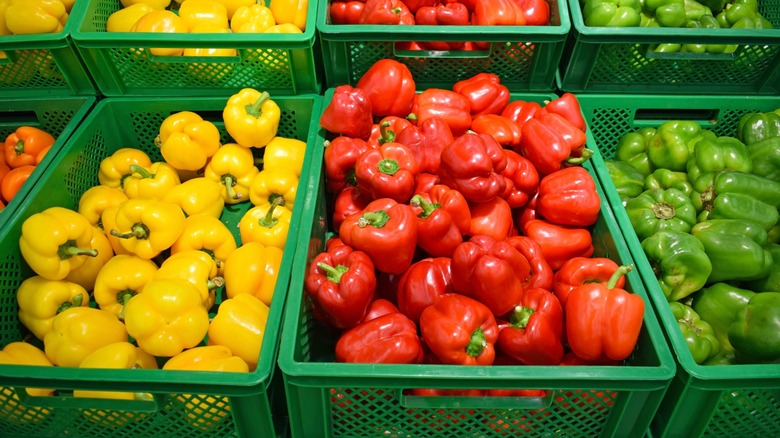The Difference Between Red, Yellow, & Green Bell Peppers
Bell peppers are a staple in many kitchens, but how well do we know what we're cooking with? For example, did you know that bell peppers are the only pepper that doesn't produce capsaicin, the chemical responsible for the spicy burn we usually associate with a hot pepper? Here's another one for you: Why are bell peppers different colors?
It can be frustrating to be standing in the produce aisle looking at the bins of bell peppers, wondering why green is so much cheaper than the other colors. Maybe you like the flavor of red more, or you think yellow will look better in your chicken salad, only to grab the green because the difference doesn't make up for the cost. But really, what is the difference? There's a myth about bell peppers going around that all bell peppers are the same and that the reason green bell peppers are so much cheaper is because they're essentially unripe versions of other bell peppers.
It makes sense at first. After all, it would cost more money to keep tending to those plants that are allowed to mature. That answer is only partly correct, though. It is true that a lot of the green bell peppers you buy at the store are unripe red bell peppers, but there are many different varieties of bell pepper — and, on top of that, every plant is different. So, while store-bought green bell peppers are usually red bell peppers in disguise, there are also varieties of bell pepper that stay green into maturity.
What are bell peppers?
Bell peppers, sometimes called sweet peppers since they lack the spicy capsaicin, are technically a type of fruit that's treated as a vegetable. Like all peppers, they originated in Mexico, Central America, and South America. Bell peppers come in many different colors. The most common varieties are green, yellow, orange, and red, but there are many other colors out there, like purple, brown, and even white. Bell peppers are some of the most in-demand vegetables in the produce aisle. In 2022, 73% percent of American households purchased bell peppers at some point, making them the sixth most popular vegetable in the country.
Bell peppers got their name because, before the development of the modern bell pepper, they actually made noise when they moved around. The plant's stigma (a remnant female part of the flower) would knock against the fruit's interior walls as they ripened, producing a loud clanging. It was so loud that, when it was windy out, it would keep the farmers awake at night and scare off any nearby cattle. This kept the peppers from being widely cultivated until 1908 when a plant breeder by the name of Gregor Carillon produced the first bell pepper that didn't make noise.
Over the past century, these silent-but-still-sweet bell peppers have skyrocketed in popularity. Interestingly, China has grown to become the undisputed frontrunner in growing bell peppers. With an eye-popping 17.6 million tons of bell peppers produced each year, they grow nearly six times as many bell peppers as the second largest producer, the peppers' native Mexico.
Why are bell peppers different colors?
The simplest answer to why bell peppers come in different colors is that there are different varieties, just like there are different varieties of apples. If you've ever tried growing bell peppers in your garden, you may be familiar with just how many options there are to choose from when selecting seeds. Some varieties produce fruit that starts forming green on the plant before maturing into its true color, while others remain the same color throughout their development.
For those of us who aren't growing our own bell peppers, our options at the grocery store are often green, red, yellow, and orange. As we said before, although there are varieties of green bell pepper that stay green through their full lifespan, most of the green bell peppers you are buying at the grocery store are unripe red bell peppers. The yellow and orange bell peppers are mature bell peppers, though. They aren't secretly red bell peppers at a different stage of development.
Do different bell peppers taste the same?
Not really, no. You're going to notice the biggest difference in taste between green bell peppers and the other colors for the simple reason that green bell peppers are usually unripe. These young peppers have a characteristically grassy, bitter taste compared to the sweet, almost fruity taste of the red, yellow, and orange bell peppers. Orange bell peppers, in particular, are known for their fruit-forward flavor profile, yellow bell peppers are relatively mild, and red bell peppers are the sweetest of the bunch but lack some of the crunch that the other color varieties offer.
To be clear, the difference in taste isn't going to alter your dish that much. If a recipe calls for red bell pepper and you use green bell pepper instead, your dinner isn't going to be ruined by any means. Of course, if the bell pepper is taking a more central role in the dish, you may want to take the different flavor profiles into consideration. For example, if you are making stuffed bell peppers and you think your filling will pair better with something more sweet than bitter (or vice versa), then you'll want to pick the right pepper for the job.
Also, for parents looking to find ways to include more vegetables in their kids' diet, you may find that the sweeter bell peppers, like red and orange, are an easier sell than the bitter green kind.
Are certain bell peppers healthier?
Any kind of bell pepper is a healthy addition to your diet. Now that that's out of the way, yes, green bell peppers have fewer nutrients than the other color varieties. The reason comes back to how much time each fruit spends maturing on the plant. Because green bell peppers are picked much earlier than the other types, they have less time to develop nutritional value.
Take vitamin C, for example. Bell peppers are one of the best sources of vitamin C in the entire produce aisle. A fully mature red bell pepper contains around 150 milligrams of vitamin C, which is twice as much vitamin C as an orange. A green bell pepper, on the other hand, only has roughly 100 milligrams of vitamin C. That's still more than you'll get from an orange, but it is a noticeable drop from a fully mature red pepper.
In fact, red bell peppers are the healthiest of all the bell peppers in the produce aisle. This is because they take the longest to mature, which means they have spent considerably more time on the plant and have fully developed all those nutrients. Yellow and orange bell peppers are solidly in the middle, though you could argue that orange bell peppers are healthier since they contain more beta-carotene than their yellow counterparts. Still quite healthy, green bell peppers do take last place in this race.
Why do some bell peppers cost more?
The cost of bell peppers directly reflects the amount of time and energy needed to produce them. Green bell peppers are harvested sooner than any other color, which means farmers don't need to spend as much time tending to them. The shorter timeframe translates to a lower price, which is why you'll see that green bell peppers are always cheaper than the other colors. For this reason, green bell peppers are typically excluded from pepper multipacks.
Prices may vary depending on where you shop for produce, but typically yellow, orange, and red bell peppers cost about the same. Red bell peppers do take the longest to develop before they are ready for harvest, so if any color is going to cost more than all the others, it's likely going to be red. It's pretty straightforward once you think about it.
Unfortunately, the cheapest option isn't the healthiest option in this case, but bell peppers are so abundant that they aren't prohibitively expensive, either. If you're really feeling the pinch of inflation, consider buying them when they're in season during the summer and early fall, as the price is slightly lower then.
